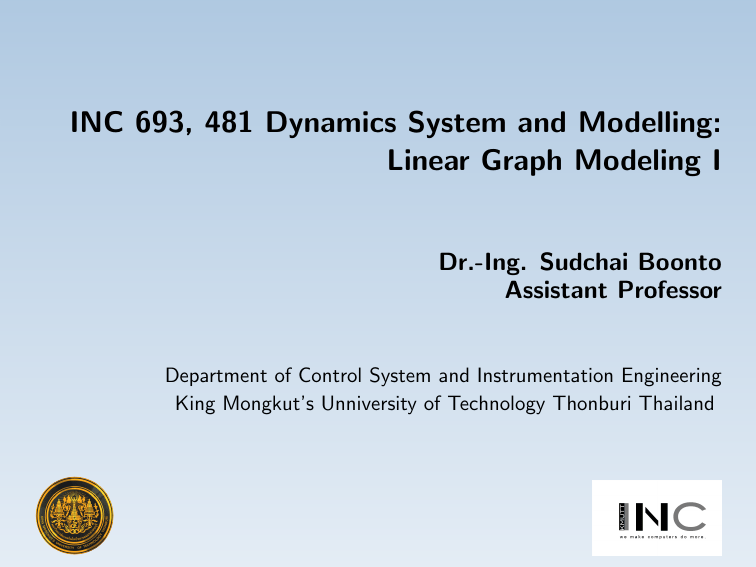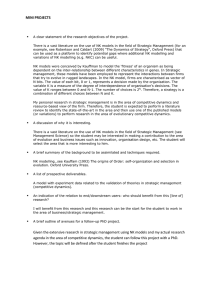INC 693, 481 Dynamics System and Modelling
advertisement

INC 693, 481 Dynamics System and Modelling: Linear Graph Modeling I Dr.-Ing. Sudchai Boonto Assistant Professor Department of Control System and Instrumentation Engineering King Mongkut’s Unniversity of Technology Thonburi Thailand Introduction to Linear Graph Models node effort variable flow variable branch graph is constructed from: A set of branches that each represent an energy port associated with a passive of source system element. A set of nodes that represent the points of interconnection of the lumped elements. INC 693, 481 Dynamics System and Modelling: , Linear Graph Modeling I J 2/20 I } Introduction to Linear Graph Models C C 111 000 Capacitance L Inductance R Resistance graph is constructed from: Capacitance elements (except electrical capacitance) must have their effort variable defined with respect to a constant reference value: velocity on mass with respect to a constant velocity inertial reference frame in fluid system the pressure is measured with respect to the reference pressure. INC 693, 481 Dynamics System and Modelling: , Linear Graph Modeling I J 3/20 I } Introduction to Linear Graph Models The arrow on the graph element of each type is drawn in the direction for which: e the effort variable associated with the branch. the flow variable f is defined as having a positive value. For source elements the arrow associated with the branch designates the sign associated with the source variable: for a flow source the arrow designates the direction defined for positive flow variable flow, and for an effort source the arrow designates the direction defined for the effort variable drop. the arrow on an effort variable source branch is commonly drawn toward the reference node. INC 693, 481 Dynamics System and Modelling: , Linear Graph Modeling I J 4/20 I } Introduction to Linear Graph Models 11 00 k 00 11 00 11 b m 00 11 00 11 00 1111111111 00000000 00 11 v v Fs (t) Figure: a simple mechanical system INC 693, 481 Dynamics System and Modelling: , Linear Graph Modeling I b k m 1111 0000 J 5/20 I } Element Interconnection Laws Compatibility Compatibility law represents a set of constraints on effort variables in the graph that may be related to physical laws. The sum of the effort variable drops on the branches around any closed loop in linear graph is identically zeros, or: N ∑ ei = 0 for any N forming a closed loop i=1 1 B 2 Loop A C 4 D 1111 0000 3 4 ∑ ei = e1 − e2 + e3 − e4 i=1 = (eA − eB ) − (eC − eB ) + (eC − eD ) − (eA − eD ) = 0 INC 693, 481 Dynamics System and Modelling: , Linear Graph Modeling I J 6/20 I } Element Interconnection Laws Compatibility The physical interpretation of the compatibility law in the various energy domains is: Mechanical systems: the velocity drops across all elements sum to zero around any closed path path in a linear graph. Electrical systems: the compatibility law is identical to KVL which states that the summation of all voltage drops around any closed loop in an electrical circuit is identically zero. Fluid systems: Pressure is a scalar potential which must sum to zero around any closed path in a fluid system. Thermal systems: Themperature is a scalar potential which must sum to zero around any closed path in a thermal system. INC 693, 481 Dynamics System and Modelling: , Linear Graph Modeling I J 7/20 I } Element Interconnection Laws Continuity Continuity law specifies constraints on the flow variables in a linear graph that may be related to physical laws. The sum of flow variables flowing into any closed contour drawn on a linear graph is zeros, or N ∑ fi = 0 for any N branches that intersect a closed contour i=1 INC 693, 481 Dynamics System and Modelling: , Linear Graph Modeling I J 8/20 I } Element Interconnection Laws Continuity 1 1 4 A 2 5 C B 3 closed contour 3 6 closed contour 2 for the right hand figure: f1 − f4 + f5 = 0, f2 − f5 − f6 = 0, −f3 + f4 + f6 = 0 for the closed contour: f1 + f2 − f3 = (f4 − f5 ) + (f5 + f6 ) − (f4 + f6 ) = 0 INC 693, 481 Dynamics System and Modelling: , Linear Graph Modeling I J 9/20 I } Element Interconnection Laws Continuity The principle of continuity corresponds to the following physical constraints: Mechanical systems: In a translational (or rotatinal) mechanical system continuity at a node arises as a direct expression of Newton’s laws of motion. Electrical systems: the continuity at an electrical node is KCL which states that the sum of currents flowing into any node in a circuit must be zero. Fluid system: the sum of volume flow rates into the junction must be zero. Thermal systms: the continuity of heat flow rate ensures that there is no accumulation of heat at any junction between elements. INC 693, 481 Dynamics System and Modelling: , Linear Graph Modeling I J 10/20 I } Sign Conventions on One-Port System Elements Electrical Circuit A i= iR Vs (t) + − R A R Vs (t) i = − R1 Vs 1 R Vs Vs (t) R (a) electrical system the compatibility equation for the middle graph is −Vs + vR = 0 then iR = 1 Vs R the compatibility equation for the right graph is Vs + vR = 0 then 1 iR = − Vs . R INC 693, 481 Dynamics System and Modelling: , Linear Graph Modeling I J 11/20 I } Sign Conventions on One-Port System Elements Mechanical System v 1 0 F = F (t) 0 1 0 1 m m F (t) 0 1 0 1 0 1 1 1111 1111110 000000 0000 v F (t) F (t) v v 11 00 F = −F (t) 00 11 00 11 m m F (t) 00 11 00 11 00 11 00 1111 11 11111 00000 0000 m F (t) F = −F (t) 01 0 1 m m 1010 F (t) 10 111 000000 111111 000 00000010 1111 111111 0000 000 111 m m F = F (t) 11 00 00 11 m m F (t) 00 11 00 11 00 11 00000 11111 000 111 00 1111 11 00000 11111 0000 000 111 m F (t) INC 693, 481 Dynamics System and Modelling: , Linear Graph Modeling I J 12/20 I } Procedure of System Graph General Procedure 1. defined the system: inputs, outputs, energy and required elements 2. for a schematic,or pictorial, model of the physical system 3. determine the system sources, energy storage and dissipation elements 4. Identify the effort variables and draw a set of nodes 5. determine the appropriate nodes for each lumped element, and inert each element into the graph 6. select a set of sign conventions for the passive elements and draw the arrows on the graph 7. select the sign conventions for the system source elements INC 693, 481 Dynamics System and Modelling: , Linear Graph Modeling I J 13/20 I } Mechanical Translational System Models Fs (t) m v Physical system 1 0 0 1 0 1 0 1 0 1 0 1 0 01 1 0 1 0 1 0 01 1 0 1 0 1 0 01 1 0 1 0 1 0 01 1 0 01 1 0 1 compatibility: Fs (t) 0110 1010 m v 10 1010 k 10 1010 1111111111 0000000000 Schematic representation v Fs (t) k 000 v 111 m ref =0 Linear graph continuity vm = vk INC 693, 481 Dynamics System and Modelling: , Linear Graph Modeling I Fs − Fk − Fm = 0 J 14/20 I } Mechanical Rotational System Models b2 ωs (t) 111111 000000 111111 000000 Motor Flywheel J ωJ (t) Bearing b1 b2 11 00 00 11 00 11 00 11 111 000 A B A ωs (t) B Physical system b1 J 1111 0000 0000 1111 Linear graph We have an angular velocity source ωs (t), a rotary inertia J, a rotary damper b1 and a rotary damper b2 the angular velocity ωJ of flywheel must be defined relative to the fixed reference node. the inner bearing rotates at the same angular velocity as the flywheel then b1 is parallel with the flywheel. INC 693, 481 Dynamics System and Modelling: , Linear Graph Modeling I J 15/20 I } Electrical Models L1 A Vs (t) L2 B + − C C1 C2 RL G (a) Electrical model L1 B L2 A C C1 C2 Vs (t) 111 000 000 G 111 RL (b) Linear graph INC 693, 481 Dynamics System and Modelling: , Linear Graph Modeling I J 16/20 I } Fluid System Models Qs (t) A Patm Reservoir R1 Tank C1 A R2 C2 B Qout Qs (t) R1 B R2 000 111 11 P 00 atm the pressure drop across valve R1 is PA − PB and so it is inserted between the two nodes A and B the outlet valve R2 discharges between the storage tank pressure PA and the reference pressure Patm , and so it is connected in parallel with C2 . INC 693, 481 Dynamics System and Modelling: , Linear Graph Modeling I J 17/20 I } Fluid System Models Long pipe effect Rp Tank Cf B pipe Rp , Ip Ip C B A Rf Rf Ps (t) A Patm Cf 111 P 000 atm the pipe is assumed to: dissipate energy through frictional losses at the walls to store energy associated with the motion of the fluid within the pipe they can be approximated by a combination of a single lumped resistance Rp and a fluid inductnace Ip . INC 693, 481 Dynamics System and Modelling: , Linear Graph Modeling I J 18/20 I } Fluid System Models Long pipe effect The two elements have a common flow Q and are described by the elemental equation: PRP = RP Q PIP = IP dQ dt for the resistance for the iductance INC 693, 481 Dynamics System and Modelling: , Linear Graph Modeling I J 19/20 I } Reference 1. Wellstead, P. E. Introduction to Physical System Modelling, Electronically published by: www.control-systems-principles.co.uk, 2000 2. Banerjee, S., Dynamics for Engineers, John Wiley & Sons, Ltd., 2005 3. Rojas, C. , Modeling of Dynamical Systems, Automatic Control, School of Electrical Engineering, KTH Royal Institute of Technology, Sweeden 4. Fabien, B., Analytical System Dynamics: Modeling and Simulation Springer, 2009 INC 693, 481 Dynamics System and Modelling: , Linear Graph Modeling I J 20/20 I }
